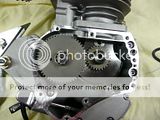Hi SPJ,
The very early NE motors [with the 26 MM carburetor] didn't use the tubing, but instead had the intake port bored into the cylinder. The early units had the same size port, but often the rear center head bolt hole extended into the port and caused a leak. Also as Mike stated some of the ports contained air pockets. You can blame me for the aluminum tube installed in the port because it was my idea to improve the flow via a smooth port and seal the rear head bolt hole at the same time.
Now a few important comments concerning the mushroom lifters [also my idea, but Whizzer altered them from my original design]. My original design was much lighter, had a level and much smaller [height] base. My advice is to forget the Rockwell test because you will be disappointed in the results.
Here are the actual results of the hardness test, they are all "soft", and some are hard on one end and soft on the other. When the machine shop called me about the Rockwell tests on 4 sets of mushroom lifters I had sent [3 stock sets , and 1 modified set], I was somewhat puzzeled by the results. When they told me the modified set was harder at the base, I expected it to be the other way around because I had machined the base. And when they told me the remaining 3 stock sets tested differently, it became even more of a mystery, because one set was harder at the base and the other 2 were harder at the top. I already knew they were soft because I used a regular drill bit in my lathe to drill the centers out, and the drill cut like a "knife through hot butter", and when I reduced the base height it didn't require a special carbide tool bit.
While it is true the softer mushroom lifters will not last as long as hardened versions, I think they will last for a long time [thousands of miles]. The only short term problem that may arize from the softer version would be wearing in one spot and not allow the lifter to spin [rotate]. The new lifters we [EZ Motorbike] had made are heat treated and are very hard, I know this because I tried to alter a couple sets for my special motors. I tried to remove a little extra from the center, and reduce the base a little more [for wieght reasons], and found it difficult to do. I gave up on removing more from the center because my drill bit only smoked and turned blue in the process, and I used a grinder to shrink the base a little more. I don't suggest anyone alter our current lifters, because I was only trying to find out how far I could "push the envelope" for performance.
If you want to machine your original mushroom set, here are the specs and methods to make them better, lighter, and durable. First let me cover the problems, they are way too heavy, the base is too large, and some have the base ground at an angle. Use a 3/16" drill and deepen the center hole within 1/4" from the bottom. Check the base to see if level, I use a mill or lathe with dial indicaters, but a simply way it to chuck up in a lathe and use a tool bit to level the base. Do not shorten the lifter any more than is necessary when leveling. I have seen some of the original lifters over 1/16" [.0625"]off level, making it impossible to adjust the lifter clearance correctly. When reducing the height of the mushroom, take metal from the top of the base. When you are done the mushroom lifter will weigh less than the WC-1 or NE replacements, will remove a lot of stress on the valve train, reduce the valves "slamming" the seats. The mushroom lifters also remove stress on the "C" clip and valve stem because the lifter "rolls" over to the flat side of the lobe as opposed to "dancing" down the ramp. For this reason using mushroom lifters on a WC-1 motor may extend the life of the motor by making a softer landing between the valve head & valve seat.
I will include a picture showing the difference between our "enhanced" version and an original mushroom unit.
Hope this information is helpful, and is not intended to bash anyone, any company, or any product.
Have fun,







